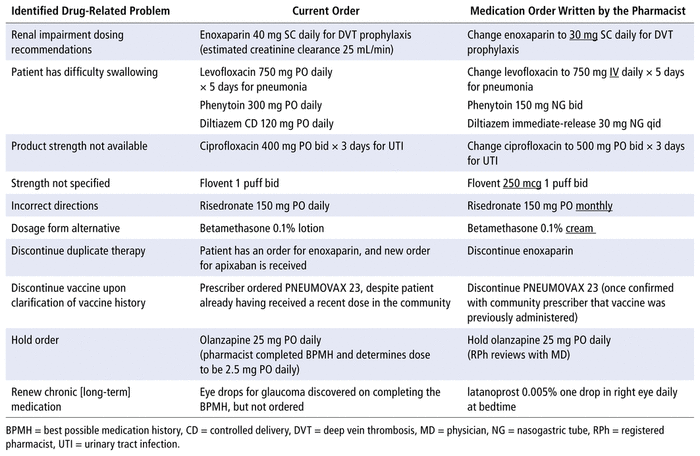
Vincent Vuong, Ramola Bhojwani, Anjana Sengar, Allan MillsABSTRACT
Background
Under Ontario’s Public Hospitals Act, the scope of professional practice of hospital pharmacists is approved by each hospital’s medical advisory committee. Some Ontario hospitals have adopted policies or medical directives related to prescription modification, allowing pharmacists to broadly adapt, discontinue, hold, or renew prescriptions as part of their clinical scope of practice.
Objectives
The primary objective of this study was to describe Ontario hospital pharmacists’ perception of their readiness to independently modify prescriptions. The secondary objectives of this study were to gather opinions on the perceived benefits, drawbacks, facilitators, and barriers to prescription modification by pharmacists and to determine how various factors affect perceived readiness.
Methods
A confidential web-based survey with Likert-type quantitative questions and qualitative open-ended questions was distributed to 936 hospital pharmacists in Ontario between May and July 2019. Mean scores were calculated for the following constructs affecting prescription modification: self-efficacy, support from the practice environment, and support from interprofessional relationships. Independent t tests were conducted to compare responses between subgroups of interest. The answers to open-ended questions were analyzed thematically.
Results
The survey had a 29% response rate (n = 271). The mean self-efficacy score was 5.2 out of 7 (standard deviation [SD] 1.0, Cronbach α = 0.88), equivalent to “quite sure”. The mean score for support from the practice environment was 3.3 out of 5 (SD 0.4, Cronbach α = 0.75), equivalent to “not a factor”. The mean score for support from interprofessional relationships was 4.2 out of 5 (SD 0.1, Cronbach α = 0.80), equivalent to “weak support”. Improved efficiency of care, timelier interventions to improve medication safety and efficacy, and improved interprofessional collaboration were cited as benefits of prescription modification by pharmacists. Potential for inappropriate decision-making and miscommunication were cited as concerns. Respondents in hospitals who were already performing prescription modification reported higher self-efficacy to modify prescriptions in clinical areas of both familiarity and unfamiliarity and greater support from prescribers.
Conclusions
A large proportion of respondents to a survey of Ontario hospital pharmacists expressed an encouraging level of readiness to independently modify prescriptions. Responses to open-ended questions in this study provided valuable insights to inform widespread adoption of this practice change.
KEYWORDS: pharmacy, hospital, Ontario, prescription, modification, adaptation
RÉSUMÉ
Contexte
En vertu de la Loi sur les hôpitaux publics de l’Ontario, le comité consultatif de chaque hôpital approuve l’élargissement de la pratique professionnelle des pharmaciens d’hôpitaux. Certains hôpitaux de l’Ontario ont adopté des politiques ou des directives médicales concernant la modification de la prescription. Celles-ci autorisent les pharmaciens à adapter, cesser, suspendre ou renouveler largement les prescriptions dans le cadre de leur champ de pratique.
Objectifs
L’objectif principal de cette étude visait à décrire la perception des pharmaciens d’hôpitaux de l’Ontario de leur degré de préparation à modifier des prescriptions de manière indépendante. Les objectifs secondaires consistaient à recueillir les opinions sur les avantages, les inconvénients, les éléments de facilitation et les obstacles perçus par les pharmaciens au sujet de la modification de la prescription et de définir comment divers facteurs influençaient la perception de leur degré de préparation.
Méthodes
Entre mai et juillet 2019, 936 pharmaciens d’hôpitaux en Ontario ont reçu une enquête confidentielle menée sur Internet comportant des questions quantitatives de type Likert et des questions ouvertes qualitatives. Les scores médians ont été calculés pour les concepts suivants liés à la modification de la prescription : l’autoefficacité, le soutien de l’environnement de pratique et le soutien des relations interprofessionnelles. Des tests t indépendants ont été menés pour comparer les réponses entre les sous-groupes sous-groupes qui intéressaient les auteurs. Les réponses aux questions ouvertes ont été analysées par thème.
Résultats
Le taux de réponses à l’enquête se montait à 29 % (n = 271). Le score moyen pour le thème « Autoefficacité » était de 5,2 sur 7 (écart type [ET] 1, Cronbach α = 0,88), ce qui équivaut à la réponse « Assez certain ». Le score moyen pour le thème « Soutien de l’environnement de pratique » était de 3,3 sur 5 (ET 0,4, Cronbach α = 0,75), ce qui équivaut à la réponse « N’est pas un facteur ». Le score moyen pour le thème « Relations interprofessionnelles » était de 4,2 sur 5 (ET 0,1, Cronbach α = 0,80), ce qui équivaut à la réponse « Soutien faible ». Les pharmaciens ont cité l’amélioration de l’efficacité des soins, les interventions en temps opportun visant à améliorer l’innocuité et l’efficacité des médicaments ainsi que l’amélioration de la collaboration interprofessionnelle comme étant des avantages de la modification indépendante des prescriptions. Ils ont aussi indiqué que le risque de prise de décision inappropriée ainsi que la mauvaise communication constituaient pour eux un sujet de préoccupation. Les répondants qui pratiquaient déjà la modification de la prescription en milieu hospitalier ont indiqué un gain d’autoefficacité de la modification des prescriptions dans des domaines cliniques qui leur sont familiers ou non, ainsi qu’un plus grand soutien de la part des prescripteurs.
Conclusions
Une grande partie des répondants à une enquête menée auprès de pharmaciens d’hôpitaux de l’Ontario ont jugé que leur degré de préparation à la modification indépendante des ordonnances était prometteur. Les réponses aux questions ouvertes de cette étude fournissent des éclaircissements précieux sur l’adoption généralisée de ce changement de pratique.
MOTS CLÉS: pharmacie, hôpital, Ontario, prescription, modification, adaptation
To improve the quality, accessibility, and sustainability of the Canadian health care system, pharmacists working in collaborative professional environments should practise to the full extent of their knowledge and expertise.1 Within the health care team, pharmacists possess a unique skill set and knowledge base related to the use of medications. In a large database study, hospital pharmacist activities such as formulary development, prescriber education, drug order review, and participation in patient care rounds were shown to reduce mortality rates.2 Randomized studies have demonstrated reductions in hospital visits, drug-related readmissions, length of hospital stay, and health care costs in association with interventions by hospital pharmacists.3,4 Pharmacists possess, at a minimum, a Bachelor of Pharmacy or Doctor of Pharmacy degree, and many pharmacists have undertaken postgraduate clinical training. Hospital pharmacists in Canada are trained to have the knowledge, skills, and judgment to make independent decisions related to drug therapy optimization, in collaboration with the patient and the care team.
While reviewing prescriptions, pharmacists regularly identify drug therapy problems, such as the wrong dose for a given indication or organ dysfunction, the wrong dosage form, the wrong drug regimen, or the wrong route of administration (Table 1). In addition, pharmacists often identify situations where discontinuing, holding, or renewing medications would be beneficial, such as duplication of therapy or medications with an inappropriate stop date. For a majority of hospitals in Ontario, current inpatient pharmacy practice involves the pharmacist contacting the prescriber to suggest a drug therapy change and documentation of any resulting telephone or verbal prescription in the patient’s chart. This process can interrupt the workflow of both the pharmacist and the prescriber and could potentially lead to delay in optimal therapy for the patient.
TABLE 1 Examples of Prescription Modification by Pharmacists
In Ontario, with the passing of Bill 179,5,6 pharmacists are now permitted to adapt and renew prescriptions while adhering to the standards of practice of the National Association of Pharmacy Regulatory Authorities7 and the Ontario College of Pharmacists (OCP) Code of Ethics.8 However, under Ontario’s Public Hospitals Act, the professional practice scope of hospital pharmacists, including prescription adaptation and renewal, must be approved by each hospital’s medical advisory committee. A minority of Ontario hospitals currently have policies or medical directives that allow for general adaptation, discontinuation, holding, or renewal of medication orders by pharmacists, without the approval and/or signature of the authorized prescriber, and that are not limited to specific drugs, drug classes, or indications. See Box 1 (glossary of terms) for the definition of prescription adaptation, as well as other terms used in this article.
BOX 1 Glossary of Terms
Outside of Ontario, several Canadian provinces have already legislated independent pharmacist prescribing, including Alberta, where pharmacists with “additional prescribing authority” can prescribe medications within their level of professional competence.10 A literature search of MEDLINE, Embase, Scopus, and IPA databases identified numerous barriers preventing prescription modification by pharmacists from becoming routine practice in Ontario hospitals, including fear of liability, lack of confidence, stress, lack of employer support, and lack of physician acceptance.11–15 To date, an assessment of the readiness of Ontario hospital pharmacists to modify prescriptions in a hospital setting has not been conducted.
The primary objective of this study was to determine, by means of a provincial survey, the perception of readiness of hospital pharmacists in Ontario to independently modify prescriptions, from individual and organizational perspectives. For the purposes of this study, prescription modification by pharmacists includes adaptation, discontinuation, holding, or renewal of medication orders. Narcotics, controlled drugs, and targeted substances were excluded, because pharmacists in Ontario do not have the authority to modify prescriptions for these medications. A secondary objective of this study was to gather opinions about the perceived benefits, drawbacks, facilitators, and barriers to pharmacists performing prescription modification, to inform the creation or adoption of tools, training materials, technology, or changes in workflow to help improve uptake. Another secondary objective was to determine how various factors, such as years of practice, location of pharmacy education, highest pharmacy degree obtained, postgraduate residency training, or hospital size, affected pharmacists’ perceived readiness to modify prescriptions in a hospital setting.
A confidential, self-administered web-based survey was made available for completion by hospital pharmacists in Ontario, Canada. The survey sample was based on a list of pharmacists, provided by the OCP, who reported practising in an accredited Ontario hospital pharmacy workplace and consented to sharing their contact information for research purposes. An email invitation to participate in the study, with a link to the online survey (using the SurveyMonkey platform), was sent to all pharmacists on this list. The initial study invitation was sent at the beginning of May 2019, with reminder emails sent at the 2-, 6-, and 10-week time points. The overall survey period was from May to July 2019. To encourage response to the survey, participants were given the opportunity to win one of two $50 gift cards. From a total of 2550 hospital pharmacists practising in Ontario at the time of this study (according to OCP data), a sample size of 334 participants was calculated to be representative for purposes of a descriptive survey, with a confidence level of 95% and a margin of error of 5%.16
Survey eligibility was limited to pharmacists in Part A of the Public Register maintained by the OCP, that is, pharmacists who were licensed in Ontario and currently practising at an accredited Ontario hospital pharmacy.9 Pharmacy interns and pharmacy students were excluded, because the study aimed to gather thoughts and experiences from practising pharmacists. Part B pharmacists were also excluded, because prescription modification would not be applicable to their practice settings.9 Additionally, the 4 authors of this manuscript were excluded from participation.
The study was approved by the Trillium Health Partners Research Ethics Board. All participants in this study provided written informed consent via the online survey tool.
To assess the readiness of Ontario hospital pharmacists to modify prescriptions, an ad hoc survey tool was designed with a mixture of quantitative Likert-type questions and qualitative open-ended questions. Existing instruments to assess readiness for change in a health care setting were either too narrow or too broad in scope, were not well suited to a health care context, or lacked reliability and validity testing.17 In their perspective article, Holt and others18 conceptualized readiness for change in health care practice as consisting of various psychological and structural factors at both individual and organizational levels. Psychological readiness describes the extent to which an individual or organization is cognitively and emotionally inclined to accept, embrace, and implement a change, whereas structural readiness describes the extent to which the circumstances surrounding an individual or organization enhance or inhibit the acceptance and implementation of change. Our survey tool aimed to measure several of these factors in relation to the adoption of prescription modification by pharmacists.
An existing survey instrument with evidence for reliability and validity was developed by Guirguis and others19 for the purpose of measuring factors that influence pharmacists’ adoption of prescribing in Alberta, Canada. We contacted the authors of that survey instrument and obtained permission to adapt their survey instrument to address our primary objective. For our Likert-type questions, we adapted 3 of the 8 scales with strong evidence for reliability and validity from the survey instrument by Guirguis and others,19 including questions about self-efficacy, support from the practice environment, and support from interprofessional relationships (for the complete survey, see Appendix 1, available at https://www.cjhp-online.ca/index.php/cjhp/issue/view/205). We included additional qualitative open-ended questions to address one of our secondary objectives.
Before the survey was launched, a pilot survey was conducted with 25 hospital pharmacists at Trillium Health Partners in Ontario, Canada, to test for face validity, comprehensibility, completeness, layout, and participant burden of the survey tool. Completion of the pilot survey did not preclude participation in the provincial survey. Median time to complete the pilot survey was 18 minutes. To reduce respondent burden, nonessential demographic questions were removed, and open-ended questions were made optional. The wording of ambiguous questions was simplified, and the order of questions was modified to facilitate survey completion. Because of issues in interpreting questions in the “support from practice environment” scale, the questions were modified to inquire about factors more specific to prescription modification, such as amount of pharmacy staffing, current workload, technology, physical environment, and employer’s expectations. All changes to the survey were approved by the Trillium Health Partners Research Ethics Board before launch of the provincial survey.
The response rate was calculated by dividing the number of survey respondents by the number of eligible participants. Survey respondents had to complete all mandatory questions to be included in the study. Demographic and practice information about survey respondents was summarized and compared with similar information for the total population of Ontario hospital pharmacists, to indicate representativeness.
Each response to a quantitative Likert-type question was converted to a numeric value. Responses were plotted and examined for normal distributions. Descriptive statistics, including means, medians, and standard deviations, were reported as appropriate for each quantitative question. We calculated means from the Likert-type scale data, as it is reasonable to do so if the data follow a normal distribution,20 and we could still draw inferences from the data because the values on our scales were reasonably distributed.21 Our revised tool was not previously tested in Ontario for the purposes of our research question, so the internal consistency of each of the 3 constructs (self-efficacy, support from the practice environment, and support from interprofessional relationships) was recalculated using the Cronbach α coefficient, a measure of how closely correlated a set of questions are within a construct. An α value greater than 0.70 was considered to indicate adequate reliability. Assuming internal consistency, overall construct mean score and standard deviation were determined by pooling the mean scores and their standard deviations for all questions within each construct. Exploratory subgroup analyses were conducted by performing independent t tests between subgroups on the mean scores of each quantitative question, with p values less than 0.05 being considered statistically significant.
For qualitative open-ended questions, thematic analysis was performed using NVivo 12 (QSR International) and Excel (Microsoft Corporation). All individual responses for each question were reviewed and coded into major themes and subthemes. Irrelevant responses to each question were removed. Each question response was reviewed numerous times, and major themes and subthemes were refined and quantified as patterns emerged. Selected quotes were highlighted.
From a list of 947 pharmacists provided by the OCP, 11 pharmacists were deemed ineligible to participate, which left a total of 936 eligible participants (Figure 1). Of the 936 eligible participants, 271 (29.0%) completed the survey. These 271 respondents represented 10.6% of the 2550 hospital pharmacists in Ontario. Relative to all hospital pharmacists in Ontario, the survey respondents were similar in distribution of gender, location of pharmacy education, and years of practice, with the caveat that the OCP Public Register reports data only for years licensed in Ontario and does not account for years of practice outside Ontario (Table 2). Of the 271 survey respondents, 56 (20.7%) reported that their hospital workplace had an existing policy or medical directive to broadly modify prescriptions, whereas 215 respondents (79.3%) reported that their workplaces did not have such policies or directives.
|
|
||
|
FIGURE 1 Flow chart of eligibility to participate in the survey. |
||
TABLE 2 Characteristics of Survey Respondents and Hospital Pharmacists in Ontario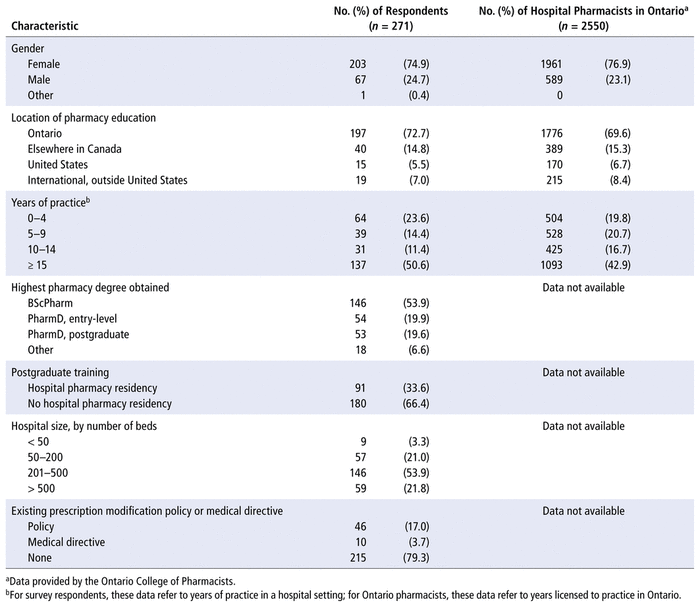
Among the 271 survey respondents, the mean score across the 7 questions for the self-efficacy scale was 5.2/7 (standard deviation [SD] 1.0, Cronbach α = 0.88), indicating that respondents were “quite sure” that they could perform various aspects of prescription modification, including patient assessment, modification within clinical areas of both familiarity and nonfamiliarity, modification of both pre-existing and newly started therapies, documentation, and acceptance of responsibility for medication management (Table 3). The mean score across the 5 questions in the “support from practice environment” scale was 3.3/5 (SD 0.4, Cronbach α = 0.75), indicating that factors such as amount of pharmacy staffing, current patient load and/or other workload, technology, the physical practice environment, and the employer’s expectations were “not a factor” in facilitating or hindering respondents’ ability to modify orders. The mean score across the 2 questions in the “support from interprofessional relationships” scale was 4.2/5 (SD 0.1, Cronbach α = 0.80), indicating that respondents felt that their relationships with prescribers, nurses, and other allied health professionals provided “weak support” in facilitating their ability to modify orders.
TABLE 3 Overall Survey Responses (n = 271)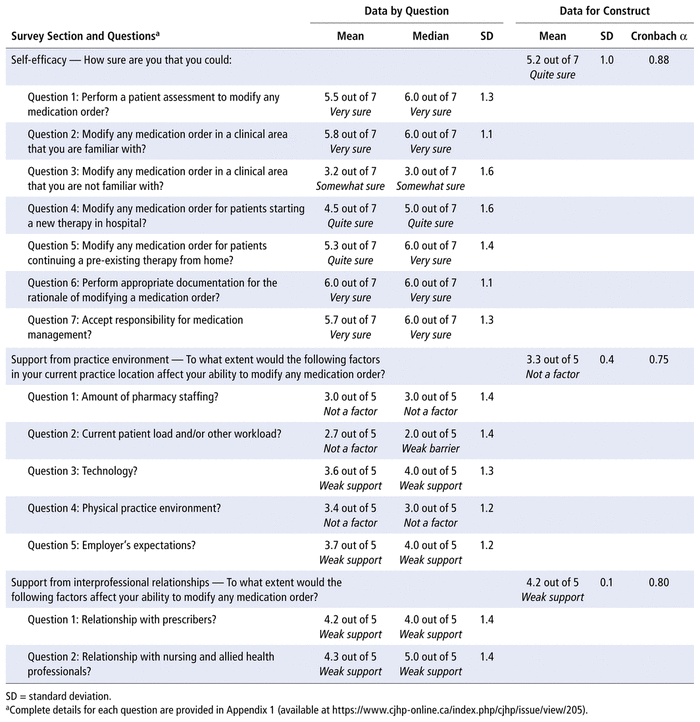
Subgroup analyses are reported in Appendix 2, Supplementary Tables S1–S7 (available at https://www.cjhp-online.ca/index.php/cjhp/issue/view/205). Respondents working in hospitals with an existing prescription modification policy or medical directive (relative to those in hospitals without such policies) reported higher self-efficacy to perform patient assessments (6.0/7 versus 5.4/7, p < 0.001), to modify orders in clinical areas of unfamiliarity (3.6/7 versus 3.1/7, p = 0.039), and to accept responsibility for medication management (6.0/7 versus. 5.6/7, p = 0.019). Respondents at these hospitals also reported greater support from employers (4.2/5 versus 3.6/5, p < 0.001), prescribers (4.6/5 versus 4.0/5, p < 0.001), and nursing and allied health professionals (4.6/5 versus 4.3/5, p = 0.007). Male respondents reported higher self-efficacy than female respondents to modify orders in clinical areas of unfamiliarity (3.6/7 versus 3.1/7, p = 0.036). Respondents with 10 years or more of practice experience (relative to those with less than 10 years of practice experience) reported amount of pharmacy staffing (2.8/5 versus 3.4/5, p = 0.001) and current patient load and/or workload (2.5/5 versus 2.9/5, p = 0.025) as greater barriers to modifying prescriptions. Respondents with pharmacy residency training (relative to those without residency training) reported greater support from employers (4.0/5 versus 3.5/5, p = 0.001), prescribers (4.4/5 versus 4.0/5, p < 0.001), and nursing and allied health professionals (4.5/5 versus 4.3/5, p = 0.037). Respondents working at hospitals with more than 500 beds (relative to those from hospitals with up to 500 beds) reported greater support from prescribers (4.4/5 versus 4.1/5, p = 0.007) but less support from pharmacy staffing (2.7/5 versus 3.2/5, p = 0.012).
Major themes and subthemes generated from the qualitative questions are summarized in Table 4. Clear benefits of prescription modification by pharmacists to pharmacy practice as a whole include reducing workload, streamlining the distribution process, resolving drug therapy problems in a timelier manner, and increasing interprofessional collaboration. Nearly 1 in 10 responses linked the ability to independently modify prescriptions with increased job satisfaction, autonomy, and engagement. One respondent noted, “[Pharmacist prescription modification] helps me develop a stronger relationship with the patient care team as I can truly be the medication expert [who] can fix the patients’ drug related problems.” Listed benefits to patients included improving medication efficacy and safety through proactive pharmacist interventions, improving patient-centred care, and providing more opportunities for patient–pharmacist interaction.
TABLE 4 Emergent Themes from Qualitative Open-Ended Questions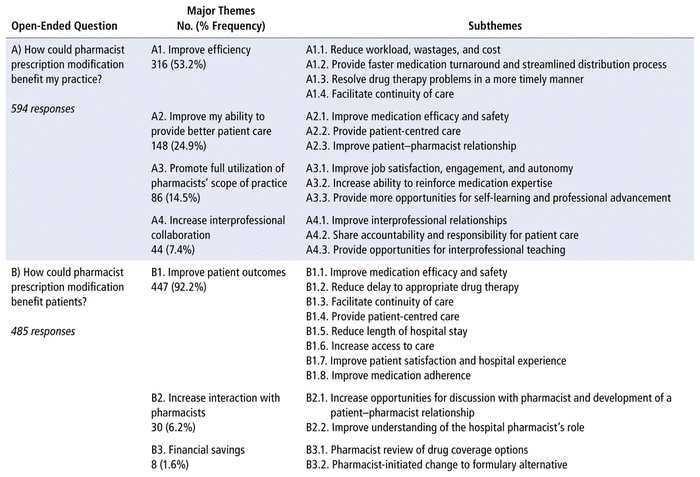
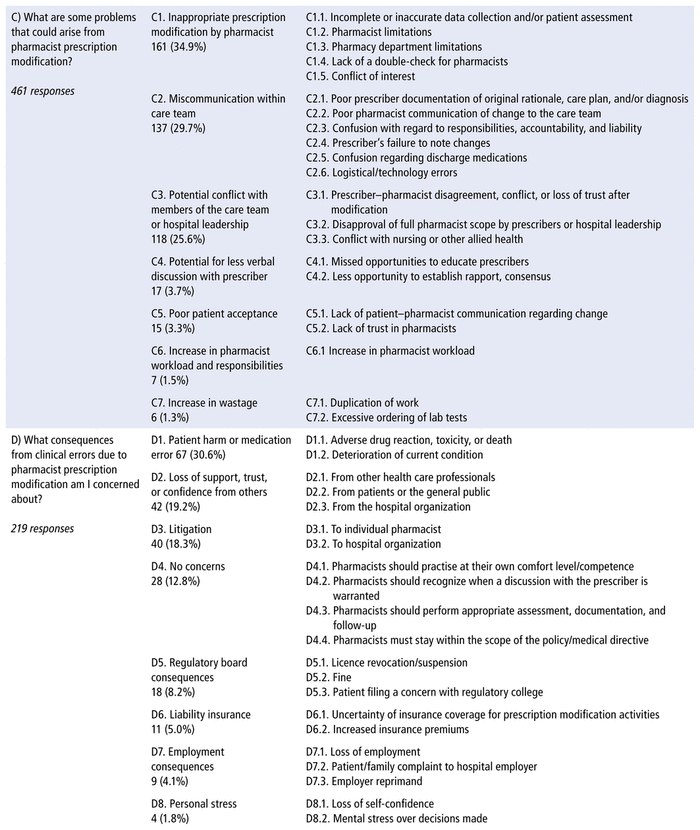
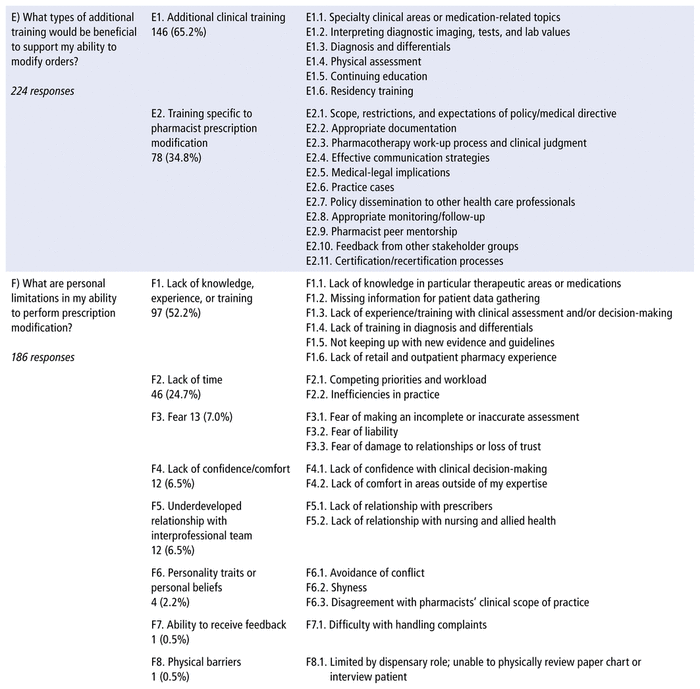
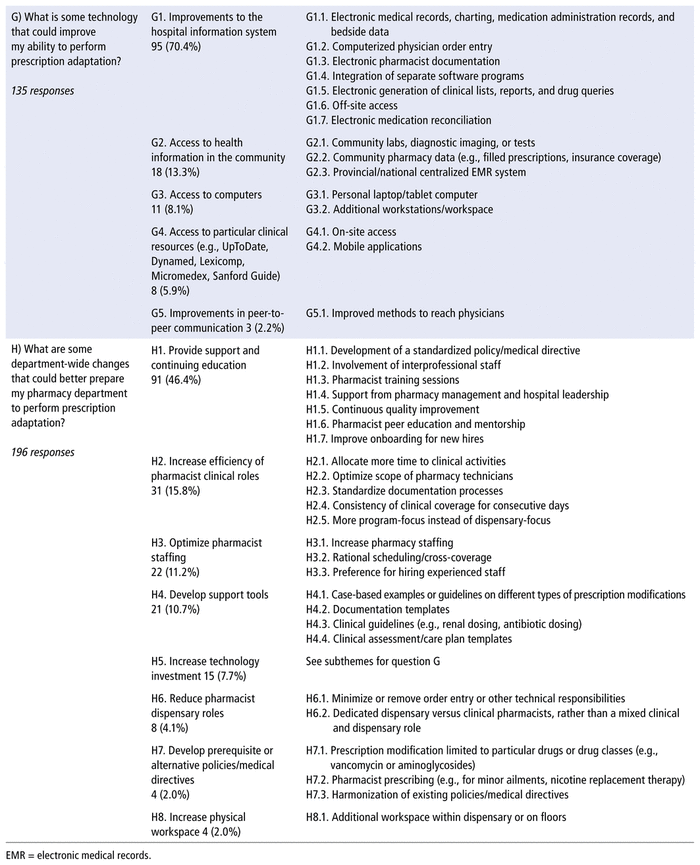
Regarding potential problems, over a third of open-ended responses cited inappropriate decision-making because of factors such as improper or insufficient data collection or patient assessment; pharmacist limitations, such as gaps in therapeutic knowledge, lack of time, or lack of confidence; and pharmacy department limitations, such as inadequate staffing and logistical issues. One respondent expressed, “Pharmacists are not trained to assess patients and therefore I don’t believe we should have the ability to largely modify prescriptions.” Another third of responses cited miscommunication within the care team as a potential concern, including poor documentation of the care plan by the prescriber, poor communication of the change by the pharmacist to the care team, and confusion about responsibilities. A quarter of responses cited the potential for conflict among members of the care team or with the hospital organization. As one respondent noted, “Physicians think pharmacists will get too much power. In my hospital this has been an issue—they view us as a threat.” Regarding personal limitations, less than 10% of responses reported personal barriers such as underdeveloped relationships with prescribers at their institution or personality traits such as avoidance of conflict or shyness. Regarding the consequences of clinical errors, respondents were most worried about harming the patient, followed by losing the trust of other health care professionals or patients, litigation, regulatory board consequences (e.g., licence revocation or suspension), and employment consequences such as loss of employment. Despite these potential consequences, roughly 15% of responses did not indicate any concerns with prescription modification by pharmacists, including the following statements from respondents: “[As pharmacists], we are professionals and need to be accountable for our decisions” and “If we are to expand our therapeutic involvement, we would naturally need to expand our liability.”
Regarding needs for additional training, two-thirds of responses cited clinical training in specialty areas such as pediatrics, intensive care, or antimicrobial stewardship, as well as other broad topics including therapeutic drug monitoring, interpreting laboratory results and diagnostic tests/imaging, approach to diagnosis and differentials, and basic physical assessments. One-third of responses to the same question supported having training to clearly outline the scope, restrictions, and expectations of any policy or medical directive, guidance on medical-legal implications, and appropriate documentation and monitoring procedures. Respondents felt that it was important to engage other health care professionals: “I think in a roll-out situation, communication to all stakeholders would be essential”. For technology, over 80% of responses cited technological improvements that would facilitate access to all necessary patient information, including computerized physician order entry, electronic medical records, e-documentation, electronic medication administration records, and access to community data. For department-wide changes, nearly half of responses suggested active support and training from leadership, including ongoing continuous quality improvement and educational procedures, such as regular auditing or competency reassessment processes. A quarter of responses suggested optimization of pharmacy staff roles, including ensuring consistent pharmacist clinical coverage on consecutive days, minimizing technical responsibilities for pharmacists, and optimizing the scope of practice of pharmacy technicians. Suggested tools included creating case-based examples of different types of prescription modifications, having standardized templates for clinical assessment and documentation, and creating hospital-specific dosing guidelines.
Responses to the survey’s quantitative questions provided valuable insights that Ontario hospital pharmacists feel they are individually ready to take on the practice change of prescription modification and do not feel that organizational factors such as their practice environment or interprofessional relationships present any barriers to performing this task. With the final sample size of 271 respondents, the quantitative results of our descriptive survey study were adequately representative of the population of hospital pharmacists in Ontario, with a confidence level of 95% and a margin of error of 6%.22
Although our subgroup analyses were exploratory in nature, we can still draw inferences from the data, because parametric methods such as the t test are robust enough to account for violations of assumptions.21 Higher scores for self-efficacy and support from interprofessional relationships for respondents working at institutions with existing prescription modification policies or medical directives suggests a positive reception for this practice change. The fact that respondents with 10 years or more of experience reported pharmacy staffing and patient load as greater barriers than did newer pharmacists may reflect the increasing clinical responsibilities of hospital pharmacists and the increasing strain of patient volumes on the Canadian health care system. Higher scores from residency-trained respondents regarding support from employers and other health care professionals could be due to factors ranging from greater comfort with working alongside the interprofessional team to feeling more valued and supported by their employers as a result of their specialized training, as well as differences in the collaborative practice environment of respondents. Compared with smaller hospitals, facilities with more than 500 beds can be subject to higher patient loads, but may have higher numbers of medical learners and residency-trained pharmacists, who could foster interprofessional collaboration.
The qualitative responses from our survey highlighted many benefits of prescription modification and identified potential limitations that pharmacists might experience. Word clouds, based on word frequency within the responses, were created to form snapshots of these perceived benefits and limitations (Figures 2 and 3). To minimize potential problems with this practice change, it is imperative that pharmacists always practise within their own comfort level and competence, putting the patient’s best interests at the core of each intervention. Pharmacists can prevent miscommunication by ensuring that appropriate verbal communication is provided to care team members within a reasonable time frame after interventions are performed. When applicable, written standardized documentation should always be provided. If pharmacists are unsure of the patient’s status and/or the prescriber’s intent, the prescriber should be contacted for clarification. If hospital pharmacy departments wish to pursue prescription modification by pharmacists, a methodical process to gather input from the pharmacy team, physician leaders, and other interprofessional staff is highly recommended. The roll-out plan should include communication and dissemination to all affected stakeholders. Offering training sessions catered to the needs and concerns of the pharmacist group and putting structures in place to maintain continuous quality improvement of the practice change are suggested.
|
|
||
|
FIGURE 2 Word cloud representing the benefits of prescription modification by pharmacists, as perceived by survey respondents. |
||
|
|
||
|
FIGURE 3 Word cloud representing limitations related to prescription modification by pharmacists, as perceived by survey respondents. |
||
A major limitation of this study was its reliance on self-reported data to provide insights into pharmacists’ perceptions of their own readiness and how other health care professionals and stakeholders may view them. Future studies could gather input from nonpharmacy stakeholders. such as prescribers, nurses, other allied health professionals, and hospital administrators. There was a risk of sampling bias and nonresponse bias, as pharmacists who volunteered to be on the OCP mailing list and completed the survey might differ significantly from those who did not complete the survey. We attempted to minimize bias by inviting a large population (over one-third of all Ontario hospital pharmacists) and matching our survey sample to the overall population of Ontario hospital pharmacists on factors such as gender, location of pharmacy education, and years of practice. Finally, this study focused on pharmacy legislation in Ontario, and its results may not be applicable outside this province. Despite differences in pharmacy practice from one province to another, it is hoped that the insights gathered from this study will be useful for preparing hospital pharmacy departments for future implementation or continuous quality improvement of similar changes in pharmacists’ scope of practice.
A large proportion of Ontario hospital pharmacists expressed an encouraging level of readiness to perform prescription modification. Future directions include conducting prospective studies to characterize the impact of this practice change on measurable outcomes and to continue the pursuit of full pharmacist scope of practice across Canada and abroad.
1 Pharmacist Prescribing Task Force. Prescribing by pharmacists: information paper (2009). Can J Hosp Pharm. 2010;63(3):267–74.
PubMed PMC
2 Bond CA, Raehl CL. Clinical pharmacy services, pharmacy staffing, and hospital mortality rates. Pharmacotherapy. 2007;27(4):481–93.
Crossref PubMed
3 Gillespie U, Alassaad A, Henrohn D, Garmo H, Hammarlund-Udenaes M, Toss H, et al. A comprehensive pharmacist intervention to reduce morbidity in patients 80 years or older: a randomized controlled trial. Arch Intern Med. 2009;169(9):894–900.
Crossref PubMed
4 Hohl CM, Partovi N, Ghement I, Wickham ME, McGrail K, Reddekopp LN, et al. Impact of early in-hospital medication review by clinical pharmacists on health services utilization. PLoS One. 2017;12(2):e0170495.
Crossref PubMed PMC
5 Regulated Health Professions Statute Law Amendment Act, 2009, S.O. 2009, c. 26 – Bill 179.
6 Ontario Regulation 202/94: General (2016). Under Pharmacy Act, 1991, S.O. 1991, c. 36.
7 Model standards of practice for Canadian pharmacists. National Association of Pharmacy Regulatory Authorities; 2009 Mar.
8 Code of ethics. Ontario College of Pharmacists; 2015 [cited 2020 Mar 30]. Available from: https://www.ocpinfo.com/library/council/download/CodeofEthics2015.pdf
9 Part A & Part B register. Ontario College of Pharmacists; 2020 [cited 2020 Mar 30]. Available from: http://www.ocpinfo.com/registration/register-pharmacist/two-part-register/
10 Pharmacists’ expanded scope of practice. Canadian Pharmacists Association; 2018 [cited 2020 Mar 30]. Available from: https://www.pharmacists.ca/pharmacy-in-canada/scope-of-practice-canada/
11 Jorgenson D, Lamb D, MacKinnon NJ. Practice change challenges and priorities: a national survey of practising pharmacists. Can Pharm J. 2011;144(3):125–31.
Crossref
12 Kondro W. Canada’s doctors assail pharmacist prescribing. CMAJ. 2007;177(6):558.
Crossref PubMed PMC
13 Child D. Hospital nurses’ perceptions of pharmacist prescribing. Br J Nurs. 2001;10:48–54.
Crossref
14 Foong EAL, Grindrod KA, Houle SKD. Will I lose my license for that? A closer look at Canadian disciplinary hearings and what it means for pharmacists’ practice to full scope. Can Pharm J. 2018;151(5):332–44.
Crossref
15 Rosenthal M, Austin Z, Tsuyuki RT. Are pharmacists the ultimate barrier to pharmacy practice change? Can Pharm J. 2010;143(1):37–42.
Crossref
16 Sample size calculator. SurveyMonkey; 2020 [cited 2020 Mar 30]. Available from: https://www.surveymonkey.com/mp/sample-size-calculator/
17 Gagnon MP, Attieh R, Ghandour el K, Légaré F, Ouimet M, Estabrooks CA, et al. A systematic review of instruments to assess organizational readiness for knowledge translation in health care. PLoS One. 2014; 9(12):e114338.
Crossref PubMed PMC
18 Holt DT, Helfrich CD, Hall CG, Weiner BJ. Are you ready? How health professionals can comprehensively conceptualize readiness for change. J Gen Intern Med. 2010;25(Suppl 1):50–5.
Crossref PubMed PMC
19 Guirguis LM, Hughes CA, Makowsky MJ, Sadowski CA, Schindel TJ, Yuksel N, et al. Development and validation of a survey instrument to measure factors that influence pharmacist adoption of prescribing in Alberta, Canada. Pharm Pract (Granada). 2018;16(1):1068.
Crossref
20 Sullivan GM, Artino AR Jr. Analyzing and interpreting data from likert-type scales. J Grad Med Educ. 2013;5(4):541–2.
Crossref
21 Norman G. Likert scales, levels of measurement and the “laws” of statistics. Adv Health Sci Educ. 2010;15(5):625–32.
Crossref
22 Margin of error calculator. SurveyMonkey; 2020 [cited 2020 Mar 30]. Available from: https://www.surveymonkey.com/mp/margin-of-error-calculator/
Competing interests: None declared. ( Return to Text )
Funding: Funding for this project was provided by the Pharmacy Department at Trillium Health Partners. ( Return to Text )
The authors acknowledge Walter Wodchis and Judith Versloot, of the Trillium Health Partners Institute for Better Health, for providing survey methodology expertise.
Canadian Journal of Hospital Pharmacy, VOLUME 74, NUMBER 3, Summer 2021